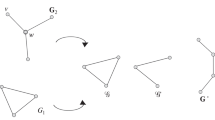Abstract
Kinematic structure of planar mechanisms addresses the study of attributes determined exclusively by the joining pattern among the links forming a mechanism. The system group classification is central to the kinematic structure and consists of determining a sequence of kinematically and statically independent-simple chains which represent a modular basis for the kinematics and force analysis of the mechanism. This article presents a novel graph-based algorithm for structural analysis of planar mechanisms with closed-loop kinematic structure which determines a sequence of modules (Assur groups) representing the topology of the mechanism. The computational complexity analysis and proof of correctness of the implemented algorithm are provided. A case study is presented to illustrate the results of the devised method.





Similar content being viewed by others
References
Artobolevski I (1988) Teoría de mecanismos y máquinas. Nauka, Moscú (in Spainsh)
Baránov G (1979) Curso de la teoría de mecanismos y máquinas. MIR, Moscú (in Spanish)
Buśkiewicz J (2006) A method of optimization of solving a kinematic problem with the use of structural analysis algorithm (SAM). Mech Mach Theory 41(7):823–837. doi:10.1016/j.mechmachtheory.2005.10.003
Campos A, Guenther R, Martins D (2009) Differential kinematics of parallel manipulators using Assur virtual chains. P I Mech Eng C-J Mech 223(7):1697–1711. doi:10.1243/09544062JMES1156
Chen G, Wang H, Zhao K, Lin Z (2009) Modular calculation of the Jacobian matrix and its application to the performance analyses of a forging robot. Adv Robot 23(10):1261–1279. doi:10.1163/156855309X462574
Durango S, Calle G, Ruiz O (2010) Analytical method for the kinetostatic analysis of the second-class RRR Assur group allowing for friction in the kinematic pairs. J Braz Soc Mech Sci Eng 32(3):200–207. doi:10.1590/S1678-58782010000300002
Galletti C (1979) On the position analysis of Assur’s groups of high class. Meccanica 14(1):6–10. doi:10.1007/BF02134963
Galletti C (1986) A note on modular approaches to planar linkage kinematic analysis. Mech Mach Theory 21(5):385–391. doi:10.1016/0094-114X(86)90086-8
Han L, Liao Q, Liang C (2000) Closed-form displacement analysis for a nine-link Barranov truss or a eight-link Assur group. Mech Mach Theory 35(3):379–390. doi:10.1016/S0094-114X(99)00016-6
Hansen M (1996) A general method for analysis of planar mechanisms using a modular approach. Mech Mach Theory 31(8):1155–1166. doi:10.1016/0094-114X(96)84606-4
Kolovsky M, Evgrafov A, Semenov Y, Slousch A (2000) Advanced theory of mechanisms and machines. Springer, Berlin
Mitsi S, Bouzakis K, Mansour G, Popescu I (2003) Position analysis in polynomial form of planar mechanisms with Assur groups of class 3 including revolute and prismatic joints. Mech Mach Theory 38(12):1325–1344. doi:10.1016/S0094-114X(03)00090-9
Mitsi S, Bouzakis KD, Mansour G (2004) Position analysis in polynomial form of planar mechanism with an Assur group of class 4 including one prismatic joint. Mech Mach Theory 39(3):237–245. doi:10.1016/S0094-114X(03)00115-0
Mlynarski T (1996) Position analysis of planar linkages using the method of modification of kinematic units. Mech Mach Theory 31(6):831–838. doi:10.1016/0094-114X(95)00120-N
Mruthyunjaya T (2003) Kinematic structure of mechanisms revisited. Mech Mach Theory 38(4):279–320. doi:10.1016/S0094-114X(02)00120-9
Peisakh E (2007) An algorithmic description of the structural synthesis of planar Assur groups. J Mach Manuf Reliab 36(6):505–514. doi:10.3103/S1052618807060015
Popescu I, Marghitu D (2008) Structural design of planar mechanisms with dyads. Multibody Syst Dyn 19(4):407–425. doi:10.1007/s11044-007-9099-6
Popescu I, Marghitu D, Stoenescu E (2006) Kinematic chains with independent loops and spatial system groups. Arch Appl Mech 75(10):739–754. doi:10.1007/s00419-006-0064-2
Reich Y, Shai O (2012) The interdisciplinary engineering knowledge genome. Res Eng Des 23(3):251–264. doi:10.1007/s00163-012-0129-x
Saura M, Celdran A, Dopico D, Cuadrado J (2014) Computational structural analysis of planar multibody systems with lower and higher kinematic pairs. Mech Mach Theory 71:79–92. doi:10.1016/j.mechmachtheory.2013.09.003
Servatius B, Shai O, Whiteley W (2010) Combinatorial characterization of the Assur graphs from engineering. Eur J Comb 31(4):1091–1104. doi:10.1016/j.ejc.2009.11.019
Tischler C, Samuel A, Hunt K (1995) Kinematic chains for robot hands-II. kinematic constraints, classification, connectivity, and actuation. Mech Mach Theory 30(8):1217–1239. doi:10.1016/0094-114X(95)00044-Y
Wang H, Lin Z, Lai X (2008) Composite modeling method in dynamics of planar mechanical system. Sci China Ser E 51:576–590. doi:10.1007/s11431-008-0035-7
Wang H, Eberhard P, Lin Z (2010) Modeling and simulation of closed loop multibody systems with bodies-joints composite modules. Multibody Syst Dyn 24:389–411. doi:10.1007/s11044-010-9208-9
Wohlhart K (2010) Position analysis of normal quadrilateral Assur groups. Mech Mach Theory 45(9):1367–1384. doi:10.1016/j.mechmachtheory.2010.03.002
Zhang Q, Zou H, Guo W (2006) Position analysis of higher-class Assur groups by virtual variable searching and its application in a multifunction domestic sewing machine. Int J Adv Manuf Technol 28:602–609. doi:10.1007/s00170-004-2379-x
Acknowledgments
The authors wish to acknowledge the technical support by Ing. Ricardo Serrano Salazar during the algorithm’s implementation. Financial support for this work was provided by the Colombian Administrative Department of Science, Technology and Innovation (COLCIENCIAS), and the Colombian National Service of Learning (SENA), Grant 1216-479-22001. The authors gratefully acknowledge this support.
Author information
Authors and Affiliations
Corresponding author
Appendix: Kinematic structure of planar mechanisms with higher pairs
Appendix: Kinematic structure of planar mechanisms with higher pairs
Kinematic and structural analysis of planar mechanisms can be done by replacing higher pairs with lower pairs. Reference [1] establishes the following condition that must be accomplished by the replacement: the equivalent mechanism preserves: a. the degree of freedom of the original one, and, b. the relative movement of all links in the particular position, e.g., the mechanism of Fig. 6a includes a higher pair formed by 2 curves hh and kk. The equivalent mechanism is constructed by tracing a normal nn at the contact point C and determining the curvature centers H and K of the corresponding curves. The equivalent has four links, where the higher pair was replaced by link 3, which forms lower pairs in H and K, Fig. 6b. The degree of freedom is preserved and the mechanism is exclusively formed by lower pairs.
Once the equivalent mechanism is determined, then it is possible to analyze the kinematic structure, for example, representing the mechanism by a graph and using Algorithm 1.
Rights and permissions
About this article
Cite this article
Durango, S., Correa, J. & Ruiz, O.E. Graph-based structural analysis of planar mechanisms. Meccanica 52, 441–455 (2017). https://doi.org/10.1007/s11012-016-0403-5
Received:
Accepted:
Published:
Issue Date:
DOI: https://doi.org/10.1007/s11012-016-0403-5





